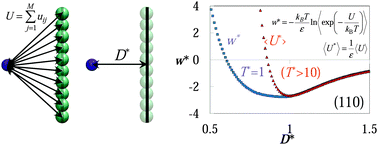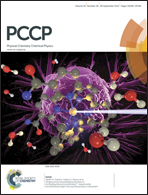Effective coarse-grained solid–fluid potentials and their application to model adsorption of fluids on heterogeneous surfaces†
Abstract
The use of effective fluid–surface potentials, in which the full positional dependence is replaced by a dependence only on the distance from the surface of the solid, is common practice as a route to reduce the complexity of evaluating adsorption of fluids on substrates. Conceptually this is equivalent to replacing the detailed description of the discrete molecular nature by a coarse-grained description in which the solid is represented by a continuous (structureless) surface. These effective fluid–surface potentials are essential in the development of theories for surface adsorption, and they provide a means to reduce the computational cost associated with the molecular simulation of the system. The main purpose of the present contribution is to emphasise the necessity of using an adequate averaging procedure to obtain effective fluid–surface potentials. A simple unweighted average of the configurational energy is commonly employed, resulting in effective potentials that are temperature independent. We describe here a procedure to develop free-energy-averaged effective fluid–surface potentials retaining the important temperature dependence of the coarse-grained interaction between the particle and the surface. Although the approach is general in nature, we assess the merits of free-energy-averaged potentials for the adsorption of methane on graphene and graphite, making appropriate comparisons with the description obtained with the more traditional temperature-independent potentials. Additionally, we develop effective fluid–surface potentials for crystalline faces of monolayer and multilayer homogeneous and heterogeneous fcc lattices based on the Lennard-Jones (12-6) pair potential, and compute the corresponding adsorption isotherms of Lennard-Jones fluids on these surfaces using Grand Canonical Monte Carlo (GCMC) simulations. The adequacy of the two different options to obtain effective fluid–surface potentials (a free-energy-based versus a simple unweighted average) is compared critically. It is shown here that the higher the heterogeneity of the surface the less adequate simple unweighted averages are to describe the adsorption behaviour in comparison to free-energy averages.


 Please wait while we load your content...
Please wait while we load your content...